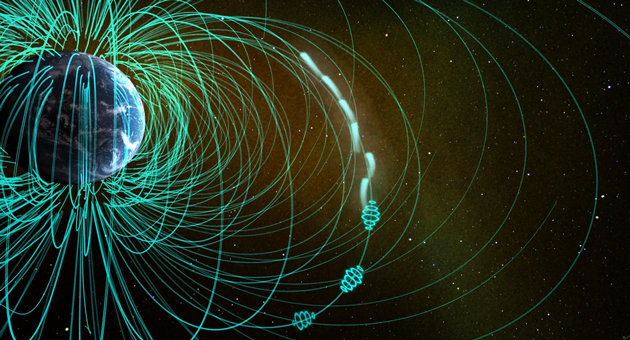Artist rendition of electrons interacting with chorus waves. Credit: ERG Science Team
Sometimes on a dark night near the poles, the sky pulses a diffuse glow of green, purple, and red. Unlike the long, shimmering veils of typical auroral displays, these pulsating auroras are much dimmer and less common. While scientists have long known auroras to be associated with solar activity, the precise mechanism of pulsating auroras was unknown. Now, new research, using data from NASA's THEMIS mission and Japan's ERG (also known as Arase) satellite, has finally captured the missing link thought responsible for these auroras. Their findings are published in the Feb. 14 issue of the journal Nature. EPSS Professor Vassilis Angelopoulos is THEMIS Principal Investigator and a co-author of the Nature article.
Earth's magnetic bubble — the magnetosphere — protects the planet from high-energy radiation coming from the Sun and interstellar space, but during particularly strong solar events, particles can slip through. Once inside, some particles become entrapped along Earth's magnetic field lines, bouncing between poles. Here, they can encounter a type of plasma wave, known as whistler mode chorus, created by fluctuating electric and magnetic fields. The waves have characteristic rising tones — reminiscent of the sounds of chirping birds — and are able to efficiently accelerate electrons. Ultimately, they scatter some of the electrons into Earth's upper atmosphere where they glow upon colliding with particles there, creating auroras.
While scientists have long believed this mechanism to be responsible for pulsating auroras, they had no definitive proof until now. The multipoint observations from the ERG satellite and ground-based all-sky cameras from the THEMIS mission allowed scientists to pinpoint the cause and effect, seeing the event from start to end.
Research done by NASA's ground-based camera and Japan's spacecraft in the unique near-Earth laboratory has applications further afield. Chorus waves have been observed around other planets in the solar system, including Jupiter and Saturn. Likely, the processes observed around Earth can explain auroras on these gas giants as well as on planets around other stars. The results also help scientists better understand how plasma waves, which occur across the universe, can influence electrons.

